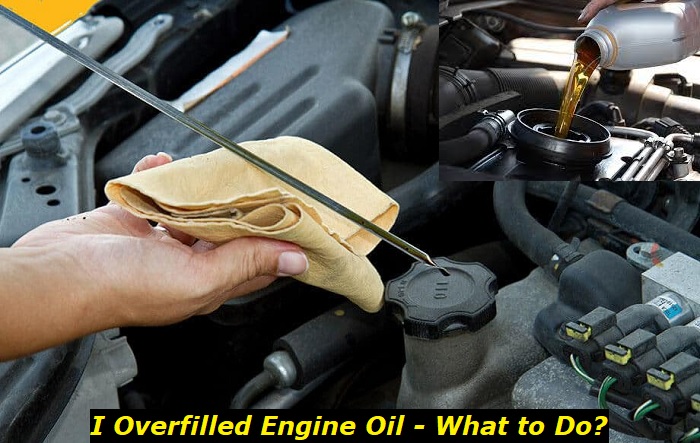The engine is an essential part of a car. For the engine to function effectively, it needs some critical substances. One such substance is engine oil. Engine oil helps to lubricate parts of the engine to ensure friction from its moving parts does not cause damage. Every engine has the ideal amount of oil it needs. Thus, underfilling or overfilling the engine with oil could be problematic.
Oil level problems highlights
- Level of urgency:medium
- Average mileage:not related to mileage
- Repair cost:$5 - $550
- DIY repair:yesbutmaybe complicated
- Commonreasons:overfilled oil, coolant leaking into oil, gas leaking into oil
- If ignored:fatal engine damage, catalytic converter damage
- How to solve:add oil or pump it outdependingon the nature of the problem

How Much Engine Oil Does a Car Need?
The amount of engine oil a car requires varies with engine type and car model. Car manufacturers recommend how much oil each vehicle needs. Generally, the size of the engine determines how much oil it demands. The bigger the engine, the more oil it will need, and vice versa.
It is common to measure motor oil in quarts. One quart is approximately equal to 0.95 liters and 946 milliliters. Typically, cars need between 4 and 8 quarts of oil depending on the size and type of engine. A four-cylinder engine usually requires between 4 and 5 quarts of oil. In comparison, 5 to 6 quarts of oil is atypical for six-cylinder engines. Eight-cylinder engines need somewhere between 6 and 8 quarts of oil. Note that these numbers may vary slightly with different car models.
How Do I Figure Out How Much Oil My Car Engine Needs?
It is much better to work with definite figures than approximations. The most reliable way to find your vehicle model's ideal oil level is to consult your vehicle manual. The manual will detail the amount of oil your engine needs, the required thickness or viscosity, and how often you need to change it.
Supposing you do not have access to the vehicle's manual. You can visit the official website of your vehicle manufacturer and get an online copy of the manual or the details you need straight from there. Alternatively, you can consult your vehicle dealer for more information.
Finally, even without a manual or guide, you can still put the ideal amount of oil in your car's engine by monitoring the dipstick. Avoid adding large amounts when engine oil is changed or topped up. Instead, add small amounts of oil to the engine and inspect the dipstick after every small addition to ensure you have not exceeded the upper limit.
What If You Overfilled the Engine Oil By 300ml?
Slightly underfilling or overfilling the engine oil is unlikely to cause any problems. Vehicle manufacturers usually account for slight deviations from their recommendations when designing. So, if the oil level on the dipstick is a little above or below the lower and upper marks, it should not cause issues.
Overfilling the engine by around 300ml is unlikely to produce significant problems. But, if you fill the engine by half a quart (473 ml) over the max or the dipstick shows foam, you might experience problems.
Whether you have overfilled the engine by 300ml or more, we recommend addressing the issue to stay safe. Overfilling the engine oil could cause some problems for the engine in the short and long term.
What Problems Could Excess Oil in The Engine Cause?
After adding oil to the engine, it resides in the oil pan at the bottom when the engine is off. When the engine is on, the oil passes through the filter to remove contaminants. Then the oil circulates throughout various parts of the machine.
There is a specific amount of oil that the oil pan can store. Yet, if you have added more oil than is necessary, the oil in the pan will rise higher than it should. As such, the crankshaft may contact the oil and aerate it. The oil becomes foamy or bubbly when aerated, hindering proper engine lubrication. Consequently, this situation creates more friction between the moving parts, causing them to wear faster and possibly damaging the engine.
Besides increased friction between engine parts or engine damage, some other issues caused by overfilling the engine with oil include:
- Oil Leakage - excessive oil creates more pressure within the engine. That pressure will force the oil to escape through different seals and gaskets, causing oil leaks from the engine.
- Crankshaft Friction - When the engine is on, the crankshaft works in high-speed rotation. Excessive oil within the crankshaft can increase friction between its components, resulting in faster wear, unusual sounds, and a less-than-ideal driving experience.
- Wet Spark Plug - excess oil can also flood the spark plug. The spark plug is essential for combustion to take place in the engine. If the spark gets damaged due to excess oil, the engine will not have the spark it needs to ignite at the right time.
Symptoms Of Excessive Oil in The Engine
- Dipstick Above Its Upper Limit - the dipstick is a measuring tool to determine how much oil is in the engine. It has two indicators to show the base and max level of oil needed. The dipstick also indicates the current status of the oil in the machine. Thus, the engine has excess oil if the oil levels have crossed the max line.
- Burning Smell - you might detect the scent of oil heating if the engine has excess oil. Burning oil smells hot and plasticky.
- High Reading on The Oil Pressure Gauge - a high oil pressure reading signifies that oil does not pass through the bores correctly or reach all engine parts in cars with oil pressure gauges. Overfilling the engine with oil can cause this reading.
- White Smoke - excess oil from the engine burning as it comes into contact with heated engine parts may cause white smoke to come out of the engine.
- Engine Misfire - the engine may misfire, rough idle, or stall if you overload the engine with oil.
- Unusual Sounds - excessive engine oil may cause weird engine sounds such as screeching or grinding.
Steps To Get Rid of Excess Oil
It is imperative to drain excess oil if you have overfilled the engine. If you have doubts about the process, you should get your vehicle towed to a mechanic. But if you want to drain the excess oil, keep reading.
Getting rid of excess oil from your engine is not particularly difficult. You can do it with tools like a car stand/lift/ramp, an oil drain pan, or any large enough liquid container. Ensure the oil drain pan can take twice the amount of oil the engine can hold to prevent spillage from the sides. Below are the steps to drain excess oil from the engine:
- Park your car on a level surface and ensure the vehicle is cold before you start the process so the hot oil does not scald you.
- Jack up the car to give yourself room to get underneath it. Avoid using floor jacks or hydraulic jacks when getting underneath a car. It would be best to support the vehicle's weight with something sturdy like a jack stand, car lift, or ramp. A garage pit will also work if you have access to one. Push down the hood a few times to test its stability. With some cars, you may not need to jack up the vehicle to get underneath.
- Place a wheel block, wood, or solid stone behind the rear wheel or both to prevent the car from rolling back.
- Slip and center the oil drain pan/container beneath the engine drain plug. The plug sits beneath the engine and is usually a foot or two from the vehicle's front.
- Open the hood/bonnet of the car and unscrew the engine's oil cap. This will allow the oil to drain faster.
- Unscrew the drain plug using a correct-sized socket or crescent wrench. Once you completely unscrew the drain plug, pull it away immediately to prevent much oil from spilling on your arm.
- Screw the plug back on after some oil has drained and check the dipstick to see if you have removed the excess oil. However, it can be difficult to screw the drain plug while the oil is still pouring out. Thus, we recommend draining all the oil before refilling the engine to the appropriate level.
- Wait at least 2-3 minutes for the oil to drain. Once the oil has stopped running out, replace the drain plug.
- Refill the engine with the oil you drained. It is also possible that you want to perform a complete oil change. In that case, refill from the container. By now, you should know how many quarts of oil your car needs. Slowly pour the measured oil back using a funnel into the fill hole. If you do not know how much oil you need, pour only small amounts into the engine. Then, check the dipstick now and then to ensure you don't exceed the upper limit.
- Screw the oil cap back on until it is tight.
- Check underneath the car to make sure there are no leaks.
- Bring the car off the stand or ramp, start the engine, and run it for a minute.
- After turning off the engine, leave it for 5 to 10 minutes so the oil can settle. Then recheck the dipstick to ensure the oil levels are where they should be. If the oil is low, add more, wait a few minutes, and check again.
Conclusion
Allowing only the necessary amount of oil into your car's engine is crucial for its effective operation and lifespan. So far, we have looked at how much oil a car engine needs and how to determine your vehicle's specific needs. We recommend removing excess oil from the engine, even if only 300ml. We have outlined the steps to do so.
It is critical to check your car's oil level when topping up to ensure you do not underfill or overfill it. If someone helped top up your engine or change the oil, do your due diligence by inspecting the dipstick afterward. If you have overfilled the engine, you should drain the excess oil. If you are not confident enough to drain the extra oil, contact your mechanic for help.
About the authors
The CarAraC research team is composed of seasoned auto mechanics and automotive industry professionals, including individuals with advanced degrees and certifications in their field. Our team members boast prestigious credentials, reflecting their extensive knowledge and skills. These qualifications include: IMI: Institute of the Motor Industry, ASE-Certified Master Automobile Technicians; Coventry University, Graduate of MA in Automotive Journalism; Politecnico di Torino, Italy, MS Automotive Engineering; Ss. Cyril and Methodius University in Skopje, Mechanical University in Skopje; TOC Automotive College; DHA Suffa University, Department of Mechanical Engineering






Add comment